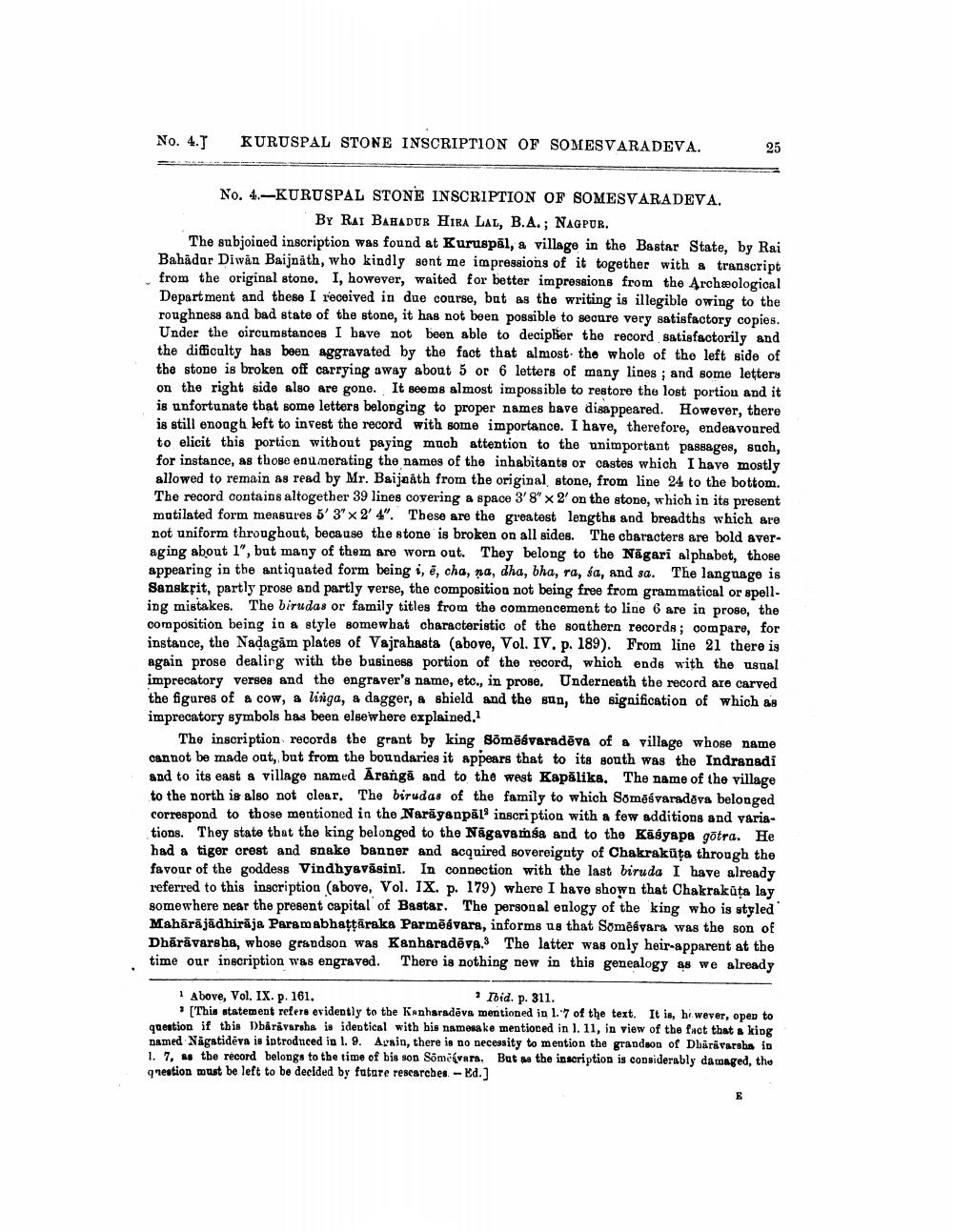________________
No. 4.T
KURUSPAL STONE INSCRIPTION OF SOMESVARADEVA.
25
No. 4.-KURUSPAL STONE INSCRIPTION OF SOMESVARADEVA.
BY RAI BAHADUR HIRA LAL, B.A.; NAGPUR. The subjoined inscription was found at Kuruspăl, a village in the Bastar State, by Rai Bahadur Diwan Baijnath, who kindly sont me impressions of it together with a transcript from the original stone. I, however, waited for better impressions from the Archeological Department and these I received in due course, but as the writing is illegible owing to the roughness and bad state of the stone, it has not been possible to secure very satisfactory copies. Under the circumstances I have not been able to decipler the record satisfactorily and the difficulty has been aggravated by the fact that almost the whole of the left side of the stone is broken off carrying away about 5 or 6 letters of many lines, and some letters on the right sido also are gone. It seems almost impossible to restore the lost portion and it is unfortunate that some letters belonging to proper names have disappeared. However, there is still enough left to invest the record with some importance. I have, therefore, endeavoured to elicit this portion without paying much attention to the unimportant passages, sach, for instance, as those enumerating the names of the inhabitants or castes which I have mostly allowed to remain as read by Mr. Baijnath from the original stone, from line 24 to the bottom. The record contains altogether 39 lines covering a space 3' 8" X 2' on the stone, which in its present mutilated form measures 5' 3" X 2'4". These are the greatest lengths and breadths which are not uniform throughout, because the stone is broken on all sides. The characters are bold averaging about 1", but many of them are worn out. They belong to the Nagari alphabet, those appearing in the antiquated form being i, e, cha, na, dha, bha, ra, sa, and sa. The language is Sanskrit, partly prose and partly verse, the composition not being free from grammatical or spelling mistakes. The birudas or family titles from the commencement to line 6 are in prose, the composition being in a style somewhat characteristic of the southern records ; compare, for instance, the Nadagam plates of Vajrahasta (above, Vol. IV. p. 189). From line 21 there is again prose dealing with tbe business portion of the record, which ends with the usual imprecatory verses and the engraver's name, etc., in prose, Underneath the record are carved the figures of a cow, a linga, a dagger, a shield and the sun, the signification of which as imprecatory symbols has been elsewhere explained.
The inscription records the grant by king Sõmēsvaradēva of a village whose name cannot be made out, but from the boundaries it appears that to its south was the Indranadi and to its east a village named Ārangã and to the west Kapálika. The name of the village to the north is also not clear. The birudas of the family to which Somēśvaradeva belonged correspond to those mentioned in the Narayanpal' inscription with a few additions and variations. They state that the king belonged to the Nāgavamsa and to the Käśyapa götra. He had a tiger crest and snake banner and acquired sovereignty of Chakraküța through the favour of the goddess Vindhyavāsini. In connection with the last biruda I have already referred to this inscription (above, Vol. IX. p. 179) where I have shown that Chakrakūta lay somewhere near the present capital of Bastar. The personal eulogy of the king who is styled Mahārājādhirāja Paramabhattāraka Parmēgvara, informs us that Somēśvara was the son of Dhārāvarsha, whose grandson was Kanharadēva. The latter was only heir-apparent at the time our inscription was engraved. There is nothing new in this genealogy 48 we already
Above, Vol. IX. p. 161.
* Ibid. p. 311. · [This statement refers evidently to the Kanharadēva mentioned in 1.7 of the text. It is, however, open to question if this Darivarsha is identical with his namesake mentioned in l. 11, in view of the fact that a king named Nagatidēva is introduced in 1. 9. Avain, there is no necessity to mention the grandson of Dhärävarsha in 1. 7, as the record belongs to the time of his son Sömesvars. But as the inscription is considerably damaged, the qnestion must be left to be decided by fatare researches -Ed.]




